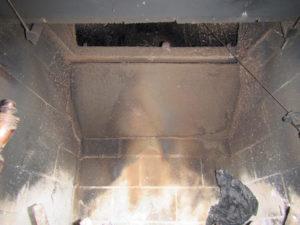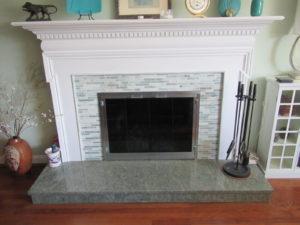- Sides of fireplace must pinch in towards back
- Back wall of fireplace must be straight up for first 12 inches
- Back wall must slope towards front for remainder of height
- Width and height of opening MUST come from table below
- Smoke shelf up above fireplace must be sized correctly – see below


Fireplace Sizing Table
All of the following dimensions are given in inches, except for Chimney Height. That value is given in feet. The firebox design is critical. Above is a photo of a masonry firebox in my own home. The rear wall of the firebox rises vertically from the floor of the fireplace and then begins to slant towards the fireplace opening just at about 14 inches. The sidewalls of the firebox are vertical. Note that the firebox is not the same width front to back. It gets narrower towards the rear of the firebox.
The firebox depth does not include the thickness of the brick – or marble tile in my case – that faces your fireplace. This is very important! You can mix and match flue sizes with chimney heights. To properly size a flue, you must use a Nomograph. See the Brick Industry Association’s Technical Note 19B – Residential Chimneys. It is always better to use the smaller flue size when you have two choices. When using the smaller flue size, you will be required to raise the height of the chimney. Taller chimneys draw better than short chimneys of the same flue size.
The smoke chamber height and design is very critical. You generally can’t see this space as it is hidden above your fireplace damper. The height of the damper is very critical as well. The bottom of the damper should be a minimum of 8 inches above the top of the fireplace opening. If your damper is not at least 8 inches above this spot, you will have smoking problems for sure!
I urge you to read the pamphlets I have mentioned from the Brick Industry Association. They have excellent illustrations which will enable you to clearly see what I am trying to explain. The following table and its values are courtesy of the Brick Industry Association.
Firebox Dimensions and Chimney Heights
| Fireplace Opening Width | 24″ | 28″ | 32″ | 36″ | 40″ | 42″ | 48″ |
| Fireplace Opening Height | 24″ | 24″ | 29″ | 29″ | 29″ | 32″ | 32″ |
| Firebox Depth | 16″ | 16″ | 16″ | 16″ | 16″ | 16″ | 18″ |
| Rear Firebox Width | 11″ | 15″ | 19″ | 23″ | 27″ | 29″ | 33″ |
| Rear Firebox Wall Vertical Height | 14″ | 14″ | 14″ | 14″ | 14″ | 16″ | 16″ |
| Nominal Flue Size | 8×12 | 8×12 | 12×12 | 12×12 | 12×16 | 12×16 | 16×16 |
| Minimum Chimney Height | 15′ | 20′ | 18.5′ | 20.5′ | 13′ | 19.5′ | 16.5′ |
